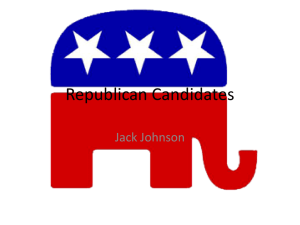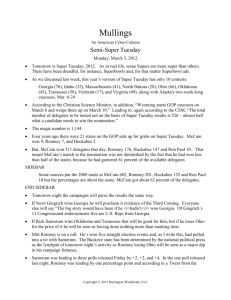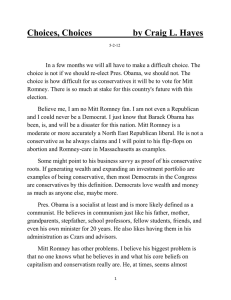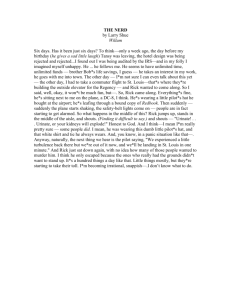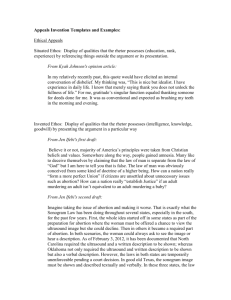The Rocky Road to the White House
advertisement
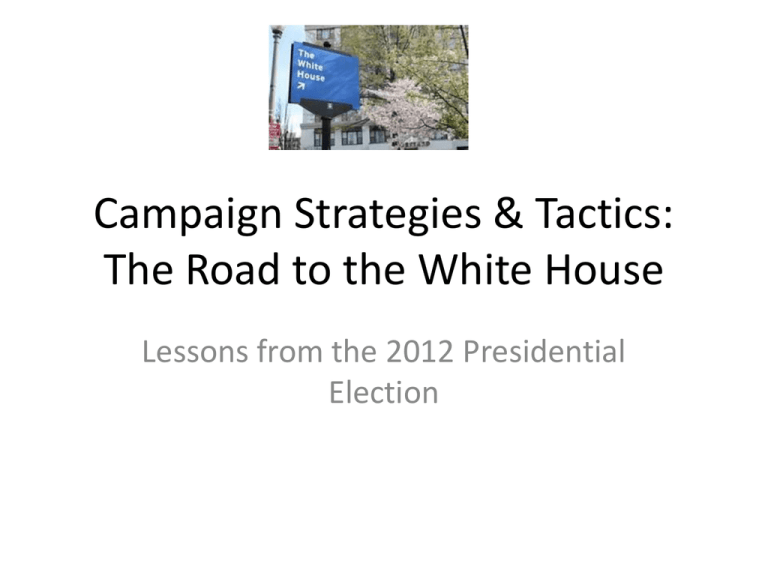
Campaign Strategies & Tactics: The Road to the White House Lessons from the 2012 Presidential Election Why Study Campaigns? • Learn about how to win elections • Learn about a potential administration: – Campaign reveals the initial policy agenda. – Top campaign staff often work later in the White House. – Campaign reveals candidate’s leadership style, especially in communications. The Long & Winding Road in American Campaigns • Presidential system • Single member plurality /Winner take all system • Two dominant parties • Two-stage process • Independents Campaign Organizations • Large specialized professional staff – Campaign manager – Media relations & strategic communications – Scheduling – Advance work – Issue research – Opposition research – – – – – – – Speech writing Advertising Fundraising Finances Accounting Legal advise Voter targeting & turnout – Volunteer coordination – Polling Polling • Importance • Impact of New Technologies Polling • By candidate organizations – Provides valuable information for strategy & tactics • By news media – Provides information on the status of the race itself – Tends to reinforce “horse-race” approach to election coverage, at the expense of policy positions Grassroots Operation • Field offices in every state. • Combined use of electronic media and door-to-door canvassing (“high tech with high touch”) Campaign Strategy • Strategy is a road map or blue print • Winston’s definition: “Achieving a desired outcome using a structured approach based on understanding existing and potential environmental elements and your opponent’s potential strategies” (p. 24). The Road Itself: Structural Factors • Nomination vs. general election strategies • Voter turnout • Geography • Incumbency Race for the 2012 GOP Nomination • Mitt Romney as apparent frontrunner – Had name recognition, donors & political organization – Has experience in both private & public spheres – Has personal wealth • But he was not alone… • One of the crowd Crowded Lanes • • • • • • • • • Mitt Romney Ron Paul Newt Gingrich Rick Santorum Rick Perry Michele Bachmann Herman Cain Jon Huntsman Tim Pawlenty Crowded Lanes • • • • • • • • Mitt Romney Ron Paul Newt Gingrich Rick Santorum Rick Perry Michele Bachmann Herman Cain Jon Huntsman Crowded Lanes • • • • • • • Mitt Romney Ron Paul Newt Gingrich Rick Santorum Rick Perry Michele Bachmann Herman Cain Crowded Lanes • • • • • • Mitt Romney Ron Paul Newt Gingrich Rick Santorum Rick Perry Michele Bachmann Less Crowded Lanes • • • • • Mitt Romney Ron Paul Newt Gingrich Rick Santorum Rick Perry Much Less Crowded Lanes • • • • Mitt Romney Ron Paul Newt Gingrich Rick Santorum Much Less Crowded Lanes • Mitt Romney • Ron Paul • Newt Gingrich Much Less Crowded Lanes • Mitt Romney • Ron Paul The Republican National Convention Tampa Florida, August 27 – 30 • The theme: A Better Future Nomination Strategies • Importance of early victories: – More convention delegates available – Greater media attention – Increased credibility as a candidate – Increased fundraising • Road hazards: Meeting high expectations. Being seen as too ideologically extreme Mending fences after bitter nomination fight Voter Turnout • • • • • • • 1960 1972-1992 1996 2000 2004 2008 2012 62.8 low 50s 49 54 60 62 57.5 Voter Turnout • Long lines plagued many polling places Geography • Fewer “swing” states: • 1960, every state was considered crucial • 1976, 30 states were in play, with almost all the largest states among the swing states. • 2004, 11 states in play • 2012, just three considered critical: Ohio, Florida and Virginia . They drew 2/3 of the campaign appearances Focusing on a Few Battleground States • A Severe Candidate Warning, from Stephen Colbert • http://www.colbertnati on.com/the-colbertreportvideos/420761/novemb er-05-2012/colbertsuper-pac---severecandidate-warning • Daily Show with Jon Stewart, “Swing State Hell,” Comedy Central. http://www.thedailysho w.com/watch/thunovember-12012/swing-state-hell Electoral College Electoral College • 2012 Impact Changes post Census • Red States gained 8 • Impact in 2004 – G.W. Bush Example seats and lost 2 • Blue States gained 4 seats and lost 10 • 12 point GOP advantage • Clear in House election: – GOP won 48.2% of vote – Dems won 49% of vote Electoral College 2012 Electoral College math on election night, 6 NOVEMBER 2012: http://www.youtube.com/watch?v=TWYQxM4G MPY (CNN, 15 minutes) http://www.youtube.com/watch?v=PypDMuGTz UA (CBS News, 4 minutes) Incumbency Advantages • • • • • • • • Free & regular media coverage A record to run on; a known quantity Organizational advantages “Presidential” persona Head of the political party Fundraising advantage Speech on Libya Some control over federal resources No intra-party challenges Incumbency Disadvantages • Electorate looking for change; blaming the president for problems • Presidential time limited: must handle demands of governing • Inability to deliver on earlier promises 14 times, presidents have lost re-election bids 16 times, presidents have won (including 3 times for FDR) President Obama as a Candidate • Record of achievement subject to interpretation. • Attacks by the political right and political left • Supporters expressed loss of idealism & hope. • Experienced campaign staff. • Strong organization. Public Approval of Obama • Low job approval but high likeability. 3rd year job approval at 44% and 4th year at 52%. Yet likeability exceeded 50% & higher than job approval The Democratic National Convention Charlotte, North Carolina, Sept. 4 – 6 David Winston’s Advice • “Thinking new” • Five steps to a winning strategy – Define the desired outcome • Winning office – specifics • Winning office by a substantial margin (to get a mandate to govern” A Mandate to Govern • Winning by a substantial margin (60% or more) creates the idea that the winner’s policies should be enacted. A mandate is useful for a new president to claim. News media reinforce this idea. • Yet are mandates real in America? – Voter turnout low – Voters vote for many reasons David Winston’s Advice • “Thinking new” • Five steps to a winning strategy – Define the desired outcome – Develop a situational awareness Situational Awareness • Accurately assessing strengths & weaknesses of your candidate & the opponent • Understanding the issues voters care about, and being flexible to change if those issue concerns change • Reading the public’s attitude about your party (the “brand”). David Winston’s Advice • “Thinking new” • Five steps to a winning strategy – Define the desired outcome – Develop a situational awareness – Identify your opponent’s potential strategies David Winston’s Advice • “Thinking new” • Five steps to a winning strategy – Define the desired outcome – Develop a situational awareness – Identify your opponent’s potential strategies – Define winning coalitions of voters David Winston’s Advice • “Thinking new” • Five steps to a winning strategy – Define the desired outcome – Develop a situational awareness – Identify your opponent’s potential strategies – Define winning coalitions of voters – Create a strategic communications plan Communications Matrix About the candidate About the opponent What we say about: our issue positions our opponent’s positions What they say about: our issue positions their own positions Create a feedback loop to adjust the strategy as needed if the political environment changes.
